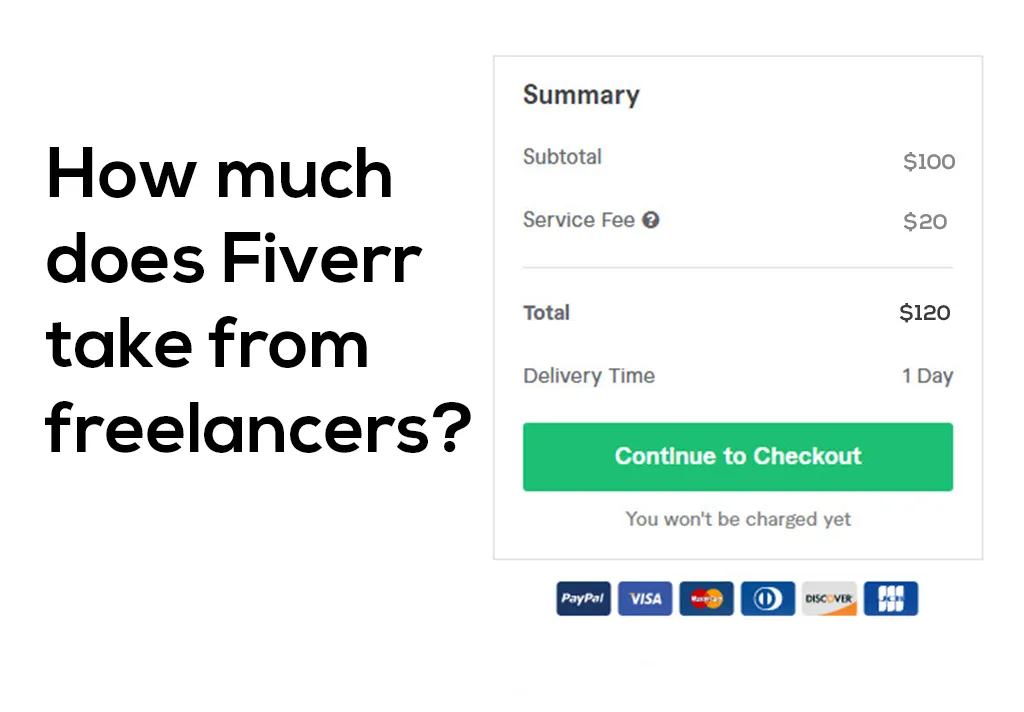If you're diving into the world of freelancing, you’ve probably heard of Fiverr. It’s like an online marketplace where freelancers can showcase their skills and buyers can find services ranging from graphic design to writing. But, before jumping in headfirst, it’s essential to understand how Fiverr's commission structure works. After all, it directly impacts the earnings of freelancers and the overall cost for buyers. In this post, we’ll unravel the intricacies of Fiverr's commission and help you make informed decisions whether you're a seller or a buyer.
What is Fiverr?

Fiverr is a popular online platform that connects freelancers with individuals and businesses in need of specific services. Founded in 2010, it was designed to offer a marketplace where people could buy and sell a wide variety of services, known as "gigs." The name "Fiverr" comes from the original concept where gigs started at just $5. Over the years, however, prices and services have expanded significantly.
The platform caters to a wide array of industries, including:
- Graphic Design: Logos, posters, and social media graphics.
- Writing & Translation: Articles, blogs, resumes, and localization services.
- Digital Marketing: SEO, social media management, and PPC advertising.
- Video & Animation: Video editing, animation, and voice-overs.
- Programming & Tech: Website development, app creation, and tech support.
One of the standout features of Fiverr is its user-friendly interface. Buyers can easily search for services, view freelancer profiles, read reviews, and compare prices. On the other hand, sellers can efficiently set up their gig offerings, showcase their portfolios, and communicate directly with potential clients.
So, in a nutshell, Fiverr is a dynamic marketplace that not only facilitates creative workflows but also encourages a global exchange of skills and services, making it a go-to platform for many freelancers and businesses alike.
Also Read This: 5 High-Paying Online Jobs for College Students
Understanding Fiverr Commission Rates

So, you’re looking to dive into the world of Fiverr and wondering just how much they take from your earnings? Trust me, you're not alone! Fiverr operates on a commission-based structure that can feel a bit overwhelming at first. The good news is, once you understand the basics, it all makes sense.
When you complete a sale on Fiverr, they take a commission based on the total value of the order. As of now, Fiverr's standard commission rate is *20% of the order price. This means that if you sell a service for $100, Fiverr will take $20, leaving you with $80. It’s pretty straightforward, right?
However, it’s important to note that this commission applies to the total amount received from the buyer, regardless of whether the order contains extras like gig upgrades or add-ons. For example, if a customer adds a $30 extra to your $100 gig, Fiverr takes 20% from the total of $130, which would be $26. So, you would end up with $104.
Beyond the commission, there's also a processing fee* for buyers, which varies based on the order size. This doesn’t directly impact your earnings but is something to keep in mind when pricing your services.
Understanding these commission rates is crucial for setting your prices effectively. You want to make sure you're still earning a satisfactory amount for your hard work. So when you're planning your gig, factor in these rates to ensure both you and your clients feel good about the price!
Also Read This: How to Hack a Fiverr Account: Understanding the Risks and Ethical Considerations
Breakdown of Fiverr Fees
Alright, let's get into the nitty-gritty of Fiverr's fees. It's crucial to know what costs might come out of your hard-earned cash while working on Fiverr. Here’s a simplified breakdown of what you need to keep an eye on:
| Fee Type | Percentage/Amount | Description |
|---|---|---|
| Standard Commission | 20% | This is the percentage Fiverr takes from your earnings after a service is sold. |
| Service Fee (Buyer) | Varies | This fee is charged to buyers at checkout, which supports the platform’s functioning. It ranges from $2 for purchases up to $40 to $5 for purchases above $40. |
| Withdrawal Fees | Varies | These are the fees associated with withdrawing your earnings, depending on your chosen withdrawal method (PayPal, bank transfer, etc.). |
It's a good idea to familiarize yourself with these fees early on to avoid surprises. For instance, while the 20% commission is quite standard, withdrawal fees can vary widely based on your payment method. Some methods may have no fees at all, while others might take a small percentage.
Always keep these factors in mind when setting your prices and think about how they can impact your overall earnings. Being informed can help you avoid hidden costs and maximize your income on Fiverr! Remember, clear pricing not only helps you earn better but also builds trust with your clients.
Also Read This: Learn About the Most Demanding Skills on Fiverr
How Fiverr Commission Affects Sellers
Understanding how Fiverr’s commission structure works is crucial for sellers seeking to maximize their profits on the platform. Fiverr typically takes a 20% commission from the total earnings of each order, which means if you sell a gig for $100, you’ll only receive $80.
This commission can have several impacts on sellers:
- Pricing Strategy: Sellers need to carefully consider their pricing to ensure they can still maintain a profit. For instance, if a seller wants to earn $100 after commission, they would need to price their gig at $125.
- Value Assessment: Sellers might feel pressured to justify their fees to clients. With Fiverr retaining a significant chunk, sellers must ensure that their service offers exceptional value to attract and retain buyers.
- Financial Planning: For full-time freelancers, understanding this commission and its impact on monthly income is vital. It allows sellers to budget effectively and plan for taxes, expenses, and personal savings.
- Service Quality: Higher commission rates might lead sellers to increase the quality of their services to support their pricing structure. This shift can enhance overall service quality on the platform.
In essence, Fiverr's commission model puts more onus on the seller, not just to deliver great services, but also to market themselves effectively. Learning to navigate these waters can make a significant difference in overall earnings.
Also Read This: Why Fiverr Forum: Exploring the Benefits and Opportunities
Tips for Managing Fiverr Commission Costs
Managing Fiverr's commission can be a challenge, but there are several strategies sellers can implement to minimize its impact on their earnings:
- Set Competitive Prices: Analyze competitors in your niche and adjust your pricing accordingly, factoring in Fiverr's commission. This can help you remain appealing to buyers while ensuring you still make a profit.
- Offer Package Deals: Instead of selling a single service at a lower price, consider bundling services into packages. This increases the overall price, helping you offset the commission while delivering greater value to clients.
- Utilize Add-Ons: Fiverr allows sellers to offer extras with their gigs. Use these options to upsell and include additional services that can justify a higher price tag.
- Maximize Customer Satisfaction: Happy customers are likely to return and recommend your services. Focus on delivering top-notch quality to encourage repeat business, which can help sustain your earnings over time.
- Track Your Earnings: Keeping an eye on your finances will help you understand how much you're making after commissions. Use this information to adjust your pricing strategies as needed.
By implementing these strategies, sellers can effectively manage Fiverr's commission and ensure they keep more of their hard-earned money. Every little bit helps in achieving overall financial goals, so it's worth taking the time to find what works best for you!
Also Read This: A Guide to Becoming a Freelance PR Consultant
7. Comparison with Other Freelance Platforms
When diving into the world of freelancing, Fiverr is often compared to several other platforms like Upwork, Freelancer, and Guru. Each of these platforms has its unique structure when it comes to commissions and fees, which can significantly affect a freelancer's earnings.
Let’s break down how Fiverr stacks up against these competitors:
| Platform | Commission Structure | Pros | Cons |
|---|---|---|---|
| Fiverr | 20% commission on sales |
|
|
| Upwork | 5% - 20% based on total earnings |
|
|
| Freelancer | 10% or $5 (whichever is greater) |
|
|
| Guru | 5% - 9% based on membership plan |
|
|
In summary, while Fiverr has its advantages with quick setup and variety, the 20% commission can be a drawback compared to platforms like Upwork and Guru, which offer lower fees for freelancers who are willing to build long-term relationships with clients. It's essential to consider what fits your freelancing style best!
8. Conclusion
Understanding Fiverr's commission structure is crucial for freelancers who want to maximize their earnings. With a straightforward 20% commission on all transactions, Fiverr creates a unique environment that can be both beneficial and challenging, depending on your approach.
While Fiverr is an excellent launchpad for new freelancers and offers a plethora of gigs, the high commission rate can limit profitability, particularly for those working on smaller projects. Evaluating Fiverr in comparison to other platforms reveals a trade-off: the simplicity and speed of getting started against potential earnings through lower commission structures found on other sites.
As you navigate the freelancing landscape, consider diversifying your presence across multiple platforms. This strategy can help you mitigate the impact of any single platform’s fees while broadening your client base. Remember, success in freelancing isn’t solely about the platform you choose; it’s also about how you market your services, the quality of your work, and how well you connect with your clients.
In the end, knowing how much Fiverr takes should empower you to set competitive prices for your services, ensuring that you remain profitable and satisfied in your freelancing journey. Happy freelancing!



